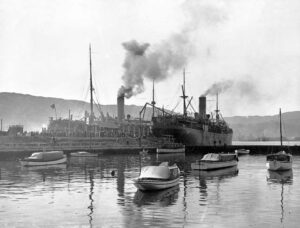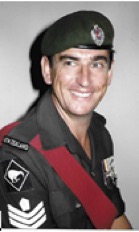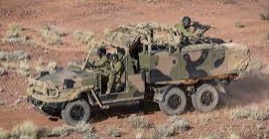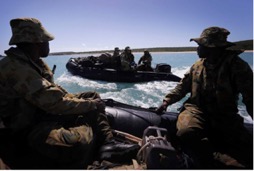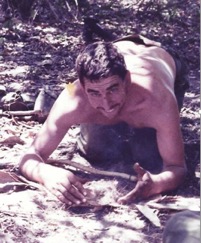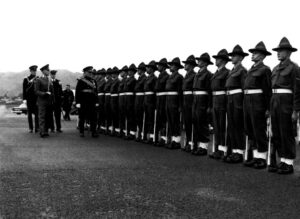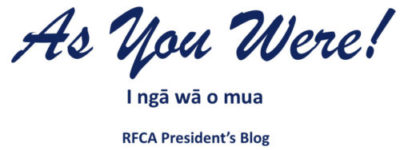
Greetings fellow Clubbies
New Zealand troop transports at Clyde Quay Wharf in Wellington, October 1914.
Well, here we are 108 years after this photo was taken, halfway through October and its 10 weeks 'til Xmas. Lots have happened since my last post in early August and I'm beginning to wonder whether we can cram much more into the rest of the year - the death of Queen Elizabeth II, threats of nuclear weapon use in Russia's Ukraine war, monster hurricanes, the USA's political reality theatre, the All Blacks winning some rugby games, and numerous other events overseas and at home have taken up all the bandwidth.
In this post we pay tribute to Warrant Officer Class One Allan Wallbutton, RNZIR, Parkinson Class (1964). Not only was Allan the same Class as me, but along with at least three others whose surnames began with 'W' - Wilson, Windelburn, Wharewera - we started off in the same section. (I was never sure why the section wasn't entirely populated with end-of-alphabeters, but as I learnt fairly quickly, Army logic was sometimes difficult to decipher.)
We also take a look at Queen Elizabeth's NZ representatives - the Governors General - who performed that role during the time of the RF Cadet School, 1948 - 1991, and which of them that we provided guards of honour for (that I could find).
Lastly, with Armistice Day coming up on November 11th, I explore the origins of some of the phrases and poems that we hear on that day (and on ANZAC Day) - Lest we forget, In Flanders Fields, and They shall grow not old,..
Tribute - one of our own
Warrant Officer Class One Allan Wallbutton, RNZIR, Parkinson Class (1964)
Allan enlisted into Parkinson Class of the Regular Force Cadet School on 13 January 1964. He completed soldier training and the Instructors Course before graduating into the Royal New Zealand Infantry Regiment in May 1965 and posted to C Company of the National Service Training Unit (NSTU) Waiouru.
In April 1967 he was posted to 1 Battalion Depot Burnham and then to NSTU Burnham. He was posted to 1 RNZIR, Terendak Malaysia in May 1968 and then to Vietnam where he served with both Victor 4 and Whiskey Two Companies as a section commander in the rank of Corporal.
On return to New Zealand in May 1970 Allan was posted to the staff of the R F Cadet School where he was promoted to Sergeant and remained until 1973.
He was next posted to C Company 3 Auckland/Northland Battalion as a cadre NCO. In 1977 he was posted as CQMS B Coy, 1 Battalion Depot and then to CQMS B Coy, 1 RNZIR, Dieppe Barracks Singapore for two years.
In 1980 Allan was posted as the Wing Sergeant Major, Tactics Wing, School of Infantry, Waiouru. In 1981 Allan participated in Exercise Longlook spending six months at the UK School of Infantry Warminster. From Waiouru Allan was posted as an instructor to the Warrant Officer Wing. Australian Infantry Centre, Singleton, New South Wales in 1983 for 2 years. On return in 1985 Allan was appointed RSM 5 Battalion, RNZIR, Wanganui and in 1987 from there to SSM, School of Infantry. Allan retired from the Army in September 1987 after 23 years of impressive service.
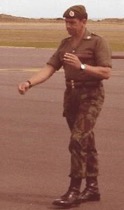 Allan took his family to Australia in 1987 and after touring most of the country settled in Darwin NT. In 1989 Allan enlisted in Australian Army Reserve as a WO2 (he had met one of his old students from the Warrant Officer courses at Singleton who was now the RSM of Norforce and persuaded him to sign up). He joined Norforce at Larrakeyah Barracks in Darwin. Allan explains: Norforce is an infantry regiment of the Australian Army Reserve. It is based on a WW2 unit, the North Australia Observer Unit which provided observation and intelligence reports across northern Australia. The regiment is one of three Regional Surveillance Units employed in surveillance, observation and the collection of military intelligence in the remote areas of northern Australia. In north Queensland there is the 51st (Far North Queensland) Battalion and to the west the Pilbara Regiment. Norforce’s AO is the Northern Territory and the Kimberley Regions of West Australia (New Zealand’s sq km would fit into the Norforce AO 6.8 times!)
Allan took his family to Australia in 1987 and after touring most of the country settled in Darwin NT. In 1989 Allan enlisted in Australian Army Reserve as a WO2 (he had met one of his old students from the Warrant Officer courses at Singleton who was now the RSM of Norforce and persuaded him to sign up). He joined Norforce at Larrakeyah Barracks in Darwin. Allan explains: Norforce is an infantry regiment of the Australian Army Reserve. It is based on a WW2 unit, the North Australia Observer Unit which provided observation and intelligence reports across northern Australia. The regiment is one of three Regional Surveillance Units employed in surveillance, observation and the collection of military intelligence in the remote areas of northern Australia. In north Queensland there is the 51st (Far North Queensland) Battalion and to the west the Pilbara Regiment. Norforce’s AO is the Northern Territory and the Kimberley Regions of West Australia (New Zealand’s sq km would fit into the Norforce AO 6.8 times!)
Norforce AO in red
Norforce consisted of RHQ, an operational support squadron and Darwin Surveillance Squadron in Darwin, in Arnhem Land at Nhulunbuy was Arnhem Surveillance Squadron, in Alice Springs Centre Surveillance Squadron and at Broome WA Kimberley Surveillance Squadron.
Allan was employed as a SSM/Training Warrant Officer in Darwin Sqn and RHQ before going on full time service and being posted to the Kimberly Squadron sub-depot at Kununurra in WA as the cadre WO. It was a married accompanied posting and the army provided a fully furnished house. SHQ was in Broome WA (an 11 hour drive) and RHQ was at Larrakeyah Barracks in Darwin NT (an 8.5 hour drive). There was one hour time difference between WA and the NT so RHQ started and finished work an hour earlier than Kimberley Squadron which made communication frustrating at times.
Norforce patrols were either infrastructure or reconnaissance and surveillance were usually of 14 days duration. Infrastructure patrols were normally vehicle patrols using LWB Toyota’s, later changing to LWB Land Rovers then Mercedes- Benz G-Wagon 6x6. The aim of infrastructure patrols was to assess resources, e.g. road and bridge conditions, cattle station airfield capabilities, buildings, water sources and supplies. This information was required to be kept up to date in case of any large unit deployments into the AO especially in the wet. North of the Tropic of Capricorn Australia has only two seasons, the wet and the dry. After the wet many of the dirt roads are washed out and need regrading. When Allan first joined the unit patrol communications to HQ’s were over HF using Morse code and one time letter pads and when he left the unit Raven radios, satellite phones and GPS were common patrol equipment.
Reconnaissance and surveillance patrols were conducted as a training activity but with missions specific to respective areas, e.g. unlawful incursions across border, conduct surveillance tasks in conjunction with Federal and NT Government when authorised and surveillance on lines of approach to facilities and resources. Aboriginal soldiers formed up to 60% of patrol members. Uniquely Norforce personnel patrol areas they come from and therefore use their local knowledge of Country and community.
Reconnaissance and surveillance patrols were inserted and extracted using Zodiac inflatable boats and/or patrol vehicles.
Vehicle patrol
Zodiac patrol
Boats and vehicles both had to be concealed and camouflaged before conducting foot patrols to man Ops etc. Boats could be deployed by vehicle to launching points or from RAN Patrol Craft or Army Landing Craft. Vehicle patrols were usually deployed at night to aid in deception and security. Consideration had to be given to vehicle/boat range and fuel, rations etc resupply with RVs, caches and air resupply being available. Training in resupply included Low Altitude Parachute Extraction from Hercules aircraft and the ever faithful Caribou for more localised support.
Patrol strength was six personnel in either two boats or two patrol vehicles. The patrol vehicles were constructed with roll bars, a rear seat that could be adjusted to face forward or to the rear and extra storage space. Personal equipment included two LMG’s and the normal spread of infantry patrol equipment. An emphasis was placed on individual survival capability.
Survival Course - Achieving Objective - Light fire using bow method
As well as being the cadre at Kununurra, Allan was also patrol commander for the patrol based at Kalumbaru in the north of the Kimberley. Kalumbaru was a mission station that had the distinction of being bombed by the Japanese in WW2. It was an 8.5 hour drive from Kununurra and on dirt roads most of the way. To deploy his patrol he had to fly one member out from Kalumbaru by charter air, where both prepared the vehicles with fuel, water, 10 man rations, communications equipment, weapons and live ammunition. They then drove the vehicles back to Kalumbaru usually taking about 1.5 days. At Kalumbaru training was conducted including field firing and if required rehearsals. The patrol then deployed. At the conclusion of the patrol both vehicles were driven back to Kununurra and post patrol administration and local leave conducted. Patrol members were then flown back into Kalumbaru by charter air.
Allan was posted back to RHQ in 1992 after completing two years in Kimberley Sqn and reverted to normal ARes training requirements. He was employed as a Training WO in the unit training wing. In 1994 he was appointed as a PSO (Proscribed Service Officer[1]) with the rank of Captain, and employed as the RLO. He conducted unit Patrol and Patrol Commanders courses and also worked out of the 7th Military District Training Wing at Larrakeyah Barracks conducting Survival Courses. Allan was also employed at the Royal Military College Detachment for the 7th Military District at Robertson Barracks in Darwin involved with the training of Ares officer cadets.
On 24 July 1995 Allan joined the NT Police as a Police Auxiliary after meeting a number of Norforce and other ARes members who recommended it as a good job. Whilst in the police he continued to be a member of the ARes.
The NT Police employed Auxiliaries in communications, watch house and front counter duties releasing Constables to more appropriate tasks. Auxiliaries were sworn members with powers of arrest but were not Constables who had a far greater range of powers. Allan was employed in the communications section as a radio operator and call taker at Police HQ in Darwin. The section incorporated three services (Police, Fire and St Johns) on shift work, each shift being supervised by a Police Sergeant. The whole of the NT Police and Emergency services were computerised with all using a common system enabling intercommunication and job sharing. After duty hour’s phones from outlying stations were switched through to the communications section so any report from a member of the public, anywhere in the NT, could be entered into the system then the appropriate on call police member contacted and called out.
Police auxiliaries covered police and fire despatch, enquiries and call taking. St Johns did their own despatch enquiries and call taking. The IT system in use was common to all three services and all police, fire and ambulance stations were also connected. Adjacent to the communications section was the Emergency Communications Centre which, when activated, was manned by police auxiliary operators for emergencies such as cyclones etc.
Allan worked in the communications section for 5 years [not bad for a grunt] then went to the NT Police College to instruct police recruits in the NT and Federal IT systems in use. He also travelled to police stations throughout the NT, as required, to conduct training in new or updated IT systems and/or procedures. Allan retired from the NT Police at age 65 but was immediately hired by the IT firm that maintained all NT Government IT systems to continue his training job as a civilian.
This is a remarkable and very interesting career. On reading this one can also appreciate the different strategic outlook Australia has as opposed to its closest neighbour. Australia is actively involved in securing its northern border and is often impatient with New Zealand’s view of our more perceived benign environment.
Allan resigned from the Australian Army in 2005 after 16 years’ service and in 2012 from the NT Police after 17 years’ service. Allan’s service in New Zealand and Australia was exemplary. He returned to New Zealand to reside in Whanganui on retirement.
Allan Wallbutton another exemplar from the ranks of Parkinson Class of the R F Cadet School.
[1] In NZ a ‘Q’ Commission.
Thanks to Bob Davies for coordinating this tribute.
NZ Governors-General 1948 - 1991
Queen Elizabeth's passing started me thinking about the Queen's representatives in New Zealand, particularly during the time the Regular Force Cadet School was operating. Many of us paraded in Guards of Honour for the GG's of the day and will remember the effort that went into practising and preparing for those events.
Guard of Honour to farewell Governor-General Lt. General the Lord Norrie, GCMG, GCVO, CB, DSO, MC at Paraparaumu Airport, 1957. Photo courtesy Roger Newth, Sinclair-Burgess Class
A bit of research on Google and in our history book, A Favoured Few, tells us that there were 10 Governors General during the period 1948 - 1991 and that the first of these was Lt. General the Lord Freyberg, VC, GCMG, KCB, KBE, DSO. In 1950 the School was asked to mount a 100-man guard for the State Opening of Parliament by Sir Bernard, but this was cancelled due to the weather. Two weeks later he came to Trentham and inspected the guard and afterwards addressed the Cadets in the Camp cinema. Lord Freyberg was Governor-General from 1946 - 1952 and Lord Norrie from 1952 - 1957. The remaining 8 G-Gs to 1991 were:
- 1957 - 1962 Viscount Cobham, GCMG, TD
- 1962 - 1967 Brigadier Sir Bernard Fergusson, GCMG, GVCO, DSO, OBE
- 1967 -1972 Sir Arthur Espie Porritt, Bt, GCMg, GCVO, CBE
- 1972 - 1977 Sir (Edward) Denis Blundell, GCMG, GCVO, KBE, QSO
- 1977 - 1980 The Rt Hon Sir Keith Jack Holyoake, KG, GCMG, CH, QSO
- 1980 - 1985 The Hon Sir David Stuart Beattie, GCMG, GCVO, QSO, QC
- 1985 - 1990 The Hon and the Rt Rev Sir Paul Alfred Reeves, GCMG, GCVO, QSO
- 1990 - 1996 The Hon Dame Catherine Anne Tizard, GCMG, GCVO, DBE, QSO
Some ex-cadets also performed duties and roles in relation to Governors-General of the day. Cam McIver, Stewart Class, was an Honorary Aide-de-Camp during Sir Paul Reeves term and Don Smith, also Stewart Class, managed Government House in Wellington (the Governor General's residence) for a number of years after retiring from the military (correct me if needed, Don). Apologies to others who have also held such roles and I haven't included you.
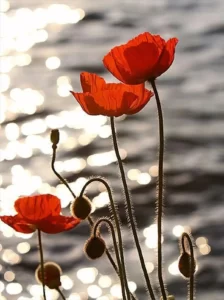 Armistice Day remembrance phrases and poems
Armistice Day remembrance phrases and poems
With Armistice Day nearly upon us, I was reminded of the special words and poems that we recite on this day and on ANZAC Day and looked up their origins:
Lest we forget. This phrase is from a poem - Recessional - that Rudyard Kipling wrote in 1897 to commemorate Queen Victoria's Diamond Jubilee. The phrase came into common use after the First World War when Armistice/Remembrance Day began to be observed. The second stanza from that poem is possibly the best known -
The tumult and the shouting dies;
The Captains and the Kings depart:
Still stands Thine ancient sacrifice,
An humble and a contrite heart.
Lord God of Hosts, be with us yet,
Lest we forget - lest we forget.
In Flanders Fields. This poem by John McCrae was written in 1915 and came to symbolise the sacrifices of all who were fighting in the First World War -
For the Fallen was written by Laurence Binyon and published in 1914. The fourth stanza of the whole poem is probably the most well-known of all -
